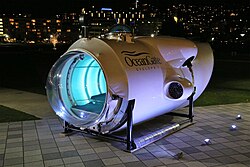
Introduction
OceanGate was a company that captured global attention with its daring deep-sea expeditions, particularly its missions to the RMS Titanic wreck. However, its legacy was forever changed in June 2023 when its Titan submersible imploded, killing all five passengers onboard. This blog dives into OceanGate’s history, the Titan disaster, safety controversies, and the future of deep-sea exploration.
1. What Was OceanGate?
Founded in 2009 by Stockton Rush, OceanGate aimed to revolutionize deep-sea exploration by making it accessible to researchers, filmmakers, and even tourists. The company developed manned submersibles capable of reaching extreme depths, including the famous Cyclops-class subs and the ill-fated Titan.
Key Objectives:
- Enable scientific research in unexplored ocean depths.
- Offer commercial deep-sea tourism (including Titanic expeditions).
- Push technological boundaries in submersible design.
2. The Titan Submersible: Innovation or Risk?
The Titan was OceanGate’s flagship submersible, designed to carry five people to depths of 4,000 meters (13,123 feet)—deep enough to reach the Titanic wreck.
Design & Specifications:
- Hull Material: Carbon fiber and titanium (unconventional for deep-sea vessels).
- Depth Rating: 4,000 meters.
- Passenger Capacity: 1 pilot + 4 crew/tourists.
- Cost per Seat: $250,000 for Titanic expeditions.
Safety Concerns:
- No Certification: Unlike most deep-sea vessels, Titan was not certified by maritime safety organizations like DNV or ABS.
- Whistleblower Warnings: Former employees raised concerns about hull integrity and testing procedures.
- Stockton Rush’s Stance: The CEO reportedly dismissed regulations, calling them barriers to innovation.
3. The Tragic Implosion (June 2023)
On June 18, 2023, the Titan submerged for a Titanic expedition but lost contact less than two hours into the dive. After a four-day international search, debris confirmed a catastrophic implosion, killing all onboard.
Victims of the Titan Disaster:
- Stockton Rush (OceanGate CEO)
- Hamish Harding (British billionaire & explorer)
- Paul-Henri Nargeolet (French Titanic expert)
- Shahzada Dawood & Suleman Dawood (Pakistani-British businessman and son)
What Caused the Implosion?
Experts believe:
- Material Fatigue: Carbon fiber degrades under repeated stress.
- Pressure Hull Failure: At 3,800 meters, water pressure is 400 times atmospheric pressure.
- Lack of Real-World Testing: Unlike military subs, Titan had limited deep-sea trials.
4. Controversies & Ethical Questions
The disaster sparked debates about deep-sea tourism regulations:
Key Issues Raised:
✔ Lack of Oversight: Private deep-sea expeditions operate in a legal gray area.
✔ Ethics of Extreme Tourism: Should civilians be allowed on high-risk missions?
✔ Corporate Responsibility: Did OceanGate prioritize profits over safety?
Legal Aftermath:
- Lawsuits from victims’ families.
- Increased scrutiny on unregulated submersible operations.
5. The Future of Deep-Sea Exploration
The Titan disaster hasn’t stopped deep-sea exploration but has led to calls for:
✅ Stricter Safety Standards (mandatory certifications).
✅ Better Emergency Protocols (tracking & rescue systems).
✅ Transparency in Submersible Design (independent testing).
Companies like Triton Submarines and EYOS Expeditions continue deep-sea missions but with certified vessels.
6 The Vision Behind OceanGate
Stockton Rush envisioned making deep-sea exploration as accessible as space tourism. His background in aerospace engineering (Princeton, Boeing) influenced OceanGate’s unconventional approach.
Key Innovations:
- Cyclops-Class Submersibles: Initial models capable of 500m dives
- Titan Development: Pushed materials science with carbon fiber hull
- Business Model: $250,000 tickets funded research expeditions
Notable Achievements:
✔ 2016: First manned expedition to SS Andrea Doria
✔ 2018: Depth certification testing to 4,000m
✔ 2021: Commenced annual Titanic expeditions
7 Inside the Titan Submersible:
Engineering Marvel or Disaster Waiting to Happen?
The Titan represented a radical departure from traditional deep-sea vehicle design:
| Feature | Traditional Submersibles | Titan |
|---|---|---|
| Hull Material | Steel/Titanium | Carbon Fiber Composite |
| Shape | Spherical (optimal pressure resistance) | Cylindrical (more interior space) |
| Viewport | Small, thick acrylic | Large, experimental design |
| Certification | Class-approved by DNV/ABS | No third-party certification |
Critical Safety Compromises:
- Hull Monitoring: Relied on acoustic sensors rather than physical testing
- Life Support: Only 96 hours of emergency oxygen
- Communication: Text messages via low-frequency acoustic modem
- Ballast System: Non-standard release mechanisms
Conclusion
OceanGate’s story is one of ambition, innovation, and tragedy. While it pushed the boundaries of deep-sea exploration, the Titan disaster serves as a warning about the risks of unregulated underwater tourism. As technology advances, balancing adventure with safety remains crucial.
External References:
- BBC: OceanGate Titan Submersible Implosion
- New York Times: The Doomed Titan Sub
- DNV Maritime Safety Standards
Disclaimer
This blog is for informational purposes only. The details are based on publicly available reports and expert analyses. We do not endorse unregulated deep-sea tourism. Always verify facts from official sources before drawing conclusions.
